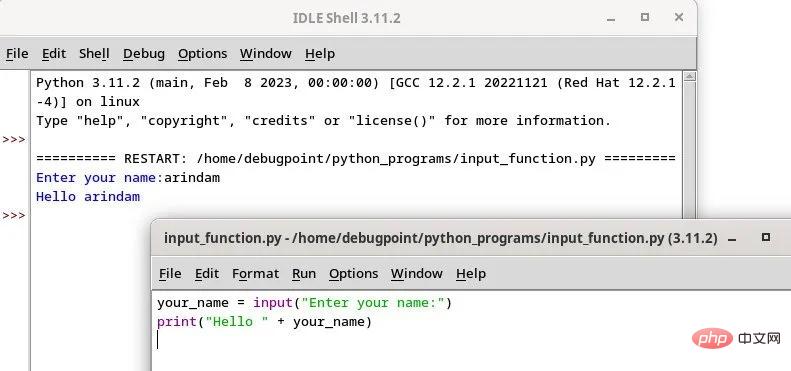Input functions in Python: concepts and examples

Python is one of the most popular programming languages in the world and is widely used in a variety of applications. A fundamental concept in Python is the input() function, which allows users to interact with a program by providing input values.
Let’s see how the input() function works and how to use it effectively in a Python program.
Before we begin, I hope you have installed Python and set up a basic editor. If not, please refer to my guide below:
- How to install Python 3.11 on Linux like Ubuntu
- How to install Python on Windows
- How to set up the IDLE editor for Python
Python Input function
The input() function in Python A string used to accept user input. It prompts the user for a value and waits for the user to provide input. The user's input is then stored in a variable as a string, which can be used later in the program.
Syntax
input("your message to user")When you run the input() function, it displays a message to the user and waits for input. Display cursor waiting. When the user enters and presses the Enter key, the input() function will read the user’s input. The value is stored in the variable you specify.
Let’s look at a few examples.
Example 1: Simple input() function usage
The following code snippet accepts input and displays output with an appended string:
your_name = input("Enter your name:")
print("Hello " + your_name)Output:
Enter your name:arindamHello arindam

Python input function: a simple example
Example 2: Taking integers and floating point numbers as input
In use input() function, you can also use int() or float() at runtime Convert the input. Here is an example:
no_of_books = int(input("Enter total books ordered:"))
print ("Total number of books:", no_of_books)
price_of_each_book = float(input("Enter unit price:"))
print ("Total price:", no_of_books * price_of_each_book)Output:
Enter total books ordered:5 Total number of books: 5 Enter unit price:10.1 Total price: 50.5
Example 3: Concatenating Lists
You can also use other functions (such as lists) to accept a set of values and join them Convert to List in Python. Here is an example that takes input and converts it into a list. Then take another set of values and append to the first list:
# 获取第一个列表的输入
list_1 = list(input("Enter numbers for list 1:"))
# 获取第二个列表的输入
list_2 = list(input("Enter some letters for list 2:"))
# 循环遍历第二个列表并添加到第一个列表
for j in list_2:
list_1.append(j)
# 打印修改后的第一个列表
print(list_1)Output:
Enter numbers for list 1:1234 Enter some letters for list 2:ABCD ['1', '2', '3', '4', 'A', 'B', 'C', 'D']
Summary
I hope this simple guide clarified it with a few examples input() function. For simple scenarios, it's a powerful function that accepts values from standard input.
The above is the detailed content of Input functions in Python: concepts and examples. For more information, please follow other related articles on the PHP Chinese website!

Hot AI Tools

Undresser.AI Undress
AI-powered app for creating realistic nude photos

AI Clothes Remover
Online AI tool for removing clothes from photos.

Undress AI Tool
Undress images for free

Clothoff.io
AI clothes remover

Video Face Swap
Swap faces in any video effortlessly with our completely free AI face swap tool!

Hot Article

Hot Tools

Notepad++7.3.1
Easy-to-use and free code editor

SublimeText3 Chinese version
Chinese version, very easy to use

Zend Studio 13.0.1
Powerful PHP integrated development environment

Dreamweaver CS6
Visual web development tools

SublimeText3 Mac version
God-level code editing software (SublimeText3)

Hot Topics
 1655
1655
 14
14
 1414
1414
 52
52
 1307
1307
 25
25
 1254
1254
 29
29
 1228
1228
 24
24
 PHP and Python: Different Paradigms Explained
Apr 18, 2025 am 12:26 AM
PHP and Python: Different Paradigms Explained
Apr 18, 2025 am 12:26 AM
PHP is mainly procedural programming, but also supports object-oriented programming (OOP); Python supports a variety of paradigms, including OOP, functional and procedural programming. PHP is suitable for web development, and Python is suitable for a variety of applications such as data analysis and machine learning.
 Choosing Between PHP and Python: A Guide
Apr 18, 2025 am 12:24 AM
Choosing Between PHP and Python: A Guide
Apr 18, 2025 am 12:24 AM
PHP is suitable for web development and rapid prototyping, and Python is suitable for data science and machine learning. 1.PHP is used for dynamic web development, with simple syntax and suitable for rapid development. 2. Python has concise syntax, is suitable for multiple fields, and has a strong library ecosystem.
 PHP and Python: A Deep Dive into Their History
Apr 18, 2025 am 12:25 AM
PHP and Python: A Deep Dive into Their History
Apr 18, 2025 am 12:25 AM
PHP originated in 1994 and was developed by RasmusLerdorf. It was originally used to track website visitors and gradually evolved into a server-side scripting language and was widely used in web development. Python was developed by Guidovan Rossum in the late 1980s and was first released in 1991. It emphasizes code readability and simplicity, and is suitable for scientific computing, data analysis and other fields.
 Python vs. JavaScript: The Learning Curve and Ease of Use
Apr 16, 2025 am 12:12 AM
Python vs. JavaScript: The Learning Curve and Ease of Use
Apr 16, 2025 am 12:12 AM
Python is more suitable for beginners, with a smooth learning curve and concise syntax; JavaScript is suitable for front-end development, with a steep learning curve and flexible syntax. 1. Python syntax is intuitive and suitable for data science and back-end development. 2. JavaScript is flexible and widely used in front-end and server-side programming.
 How to run sublime code python
Apr 16, 2025 am 08:48 AM
How to run sublime code python
Apr 16, 2025 am 08:48 AM
To run Python code in Sublime Text, you need to install the Python plug-in first, then create a .py file and write the code, and finally press Ctrl B to run the code, and the output will be displayed in the console.
 Can vs code run in Windows 8
Apr 15, 2025 pm 07:24 PM
Can vs code run in Windows 8
Apr 15, 2025 pm 07:24 PM
VS Code can run on Windows 8, but the experience may not be great. First make sure the system has been updated to the latest patch, then download the VS Code installation package that matches the system architecture and install it as prompted. After installation, be aware that some extensions may be incompatible with Windows 8 and need to look for alternative extensions or use newer Windows systems in a virtual machine. Install the necessary extensions to check whether they work properly. Although VS Code is feasible on Windows 8, it is recommended to upgrade to a newer Windows system for a better development experience and security.
 Where to write code in vscode
Apr 15, 2025 pm 09:54 PM
Where to write code in vscode
Apr 15, 2025 pm 09:54 PM
Writing code in Visual Studio Code (VSCode) is simple and easy to use. Just install VSCode, create a project, select a language, create a file, write code, save and run it. The advantages of VSCode include cross-platform, free and open source, powerful features, rich extensions, and lightweight and fast.
 How to run python with notepad
Apr 16, 2025 pm 07:33 PM
How to run python with notepad
Apr 16, 2025 pm 07:33 PM
Running Python code in Notepad requires the Python executable and NppExec plug-in to be installed. After installing Python and adding PATH to it, configure the command "python" and the parameter "{CURRENT_DIRECTORY}{FILE_NAME}" in the NppExec plug-in to run Python code in Notepad through the shortcut key "F6".




